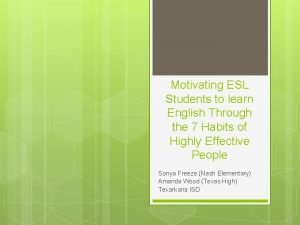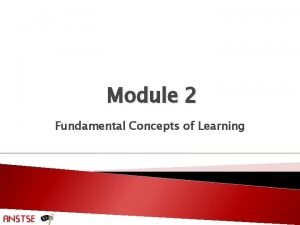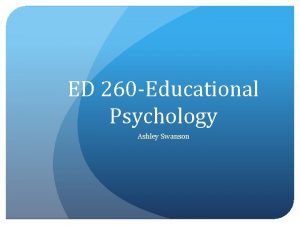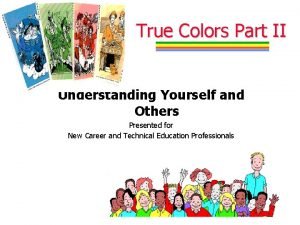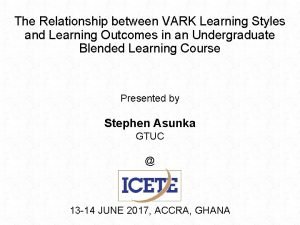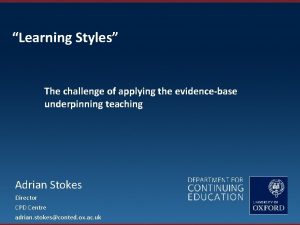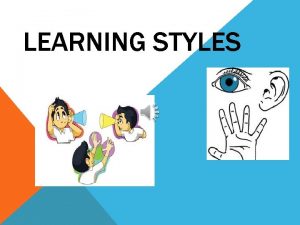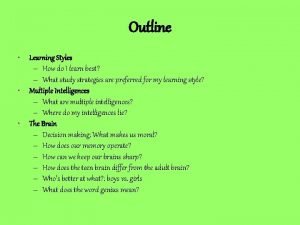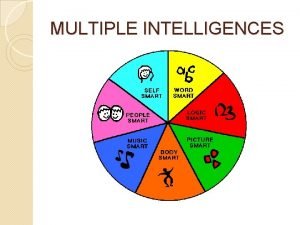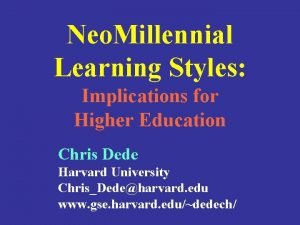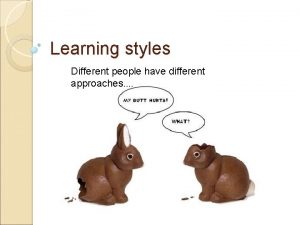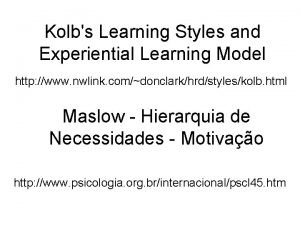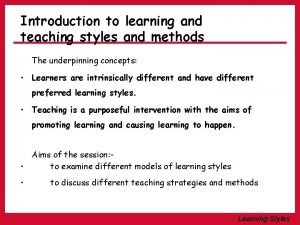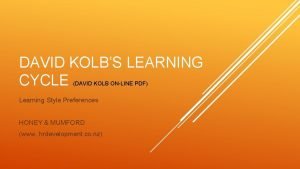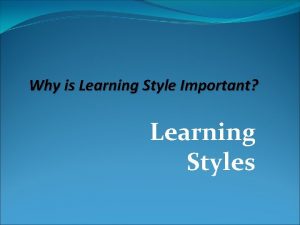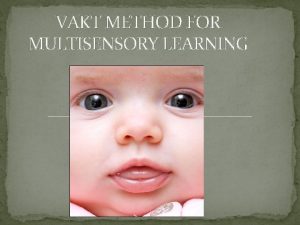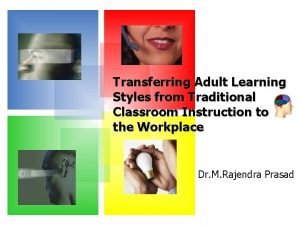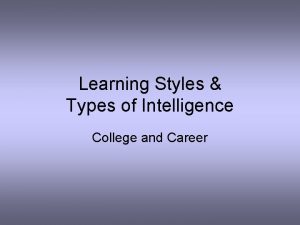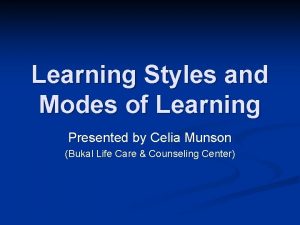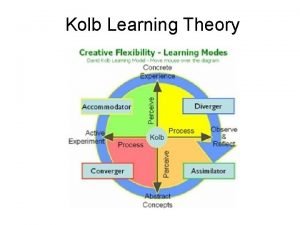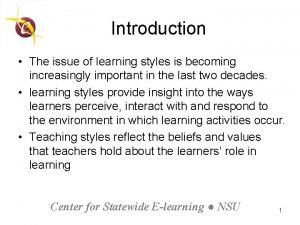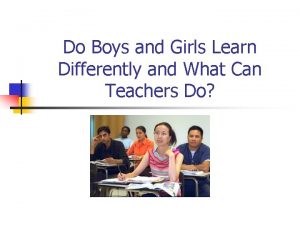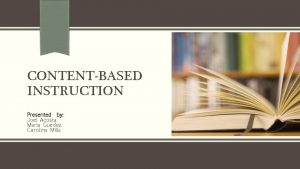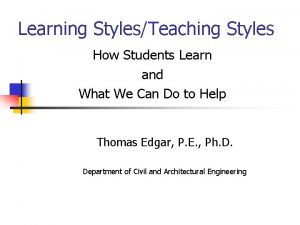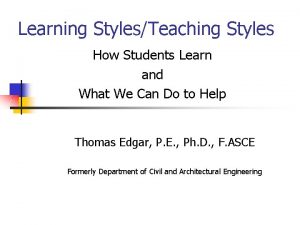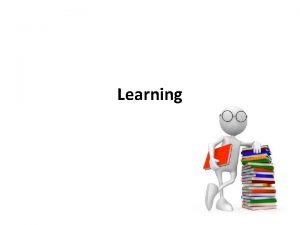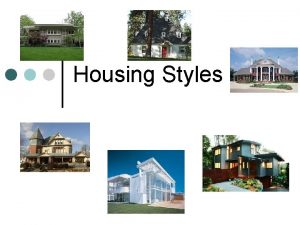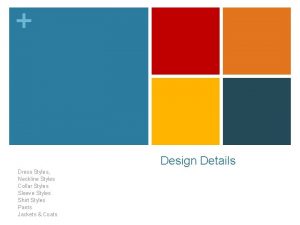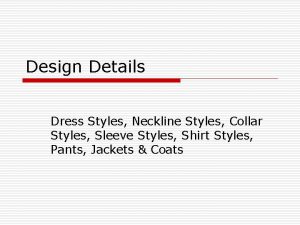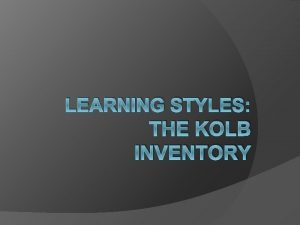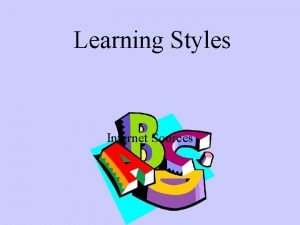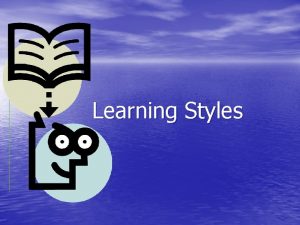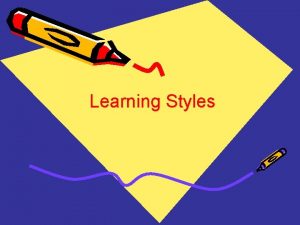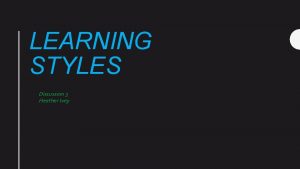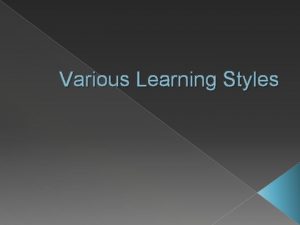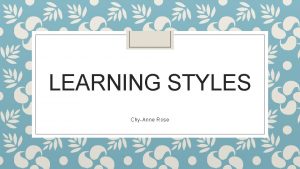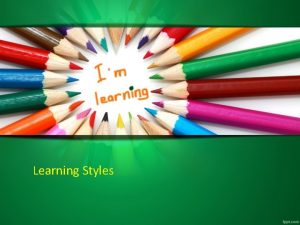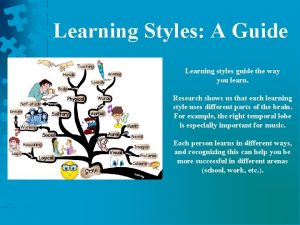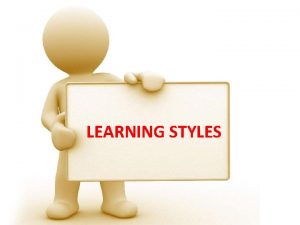Learning StylesTeaching Styles How Students Learn and What






























- Slides: 30

Learning Styles/Teaching Styles How Students Learn and What We Can Do to Help Thomas Edgar, P. E. , Ph. D. , F. ASCE Formerly Department of Civil and Architectural Engineering

Theoretical Underpinnings to Learning Theory and Its Application to Use in the Engineering Classroom n n Learning Theory has been a matter of speculation from the Ancient Greeks to the Present Day. Plato, famed for his ability to think through a situation and make incorrect conclusions about it, believed that learning was achieved by a transmittal of sound through a physical vapor to the ear, which received the sound like an echo in a cave and entered the head where it could be processed through a logical process of processing each individual sound adding those sounds up into intelligible phrases that the mind, ever open to receiving those vaporous noises, can contemplate and store into boxes arranged throughout the head where the information could be retrieved and reprocessed in a spontaneous and liquid manner to convey the information to pupils. Can you hear me now?

Let’s Look at Some Terms and What They Mean Teaches to Aid the Student to… The Professor You Aid, but the student The Student has to do the Work to make that Knowledge Useful… Intellectual Curiosity Gain and Synthesize Knowledge, i. e. , Learn Knowledge

Teaching Tools n Teachers have a lot of options to Aid Learning n n n Lectures Laboratory Reading n n Textbooks Internet n n n Google Lifelong Learning Intellectual Curiosity n Shaw and Southwell n Hardy Cross Homework Projects (esp. Group) Site Visits Coding n “Gray Box” n n Sketching/Drawing beyond FBD n n White out pieces of code for students to fill in. Works for c and excel. Visual Problem Solving Lots of Others!

It isn’t just a Stockpile of Knowledge

It’s a Way of Thought n (Pretty Picture)

How Do You Learn? n n n This is a question that is often asked and certainly fits with the topic…. but This is NOT a Rhetorical Question!!! How Do YOU Learn? n n n Pick a Topic – A Hobby, An Investment, Something Technical (not your research)…. . What are all the ways you can learn about it? ? ? Group the list of ways they learn….

What do We Gather from That? Read and Watch Attempt / Trial and Error Do Contemplate and Analyze/Improve

What do We Gather from That? Read and Watch Attempt / Trial and Error Do Contemplate and Analyze/Improve

What do We Gather from That? Read and Watch Attempt / Trial and Error Do Contemplate and Analyze/Improve

What do We Gather from That? Read and Watch Attempt / Trial and Error Do Contemplate and Analyze/Improve

What do We Gather from That? Read and Watch Attempt / Trial and Error Do Contemplate and Analyze/Improve

What do We Gather from That? Read and Watch Attempt / Trial and Error Do Contemplate and Analyze/Improve

What do We Gather from That? Read and Watch Attempt / Trial and Error Do Contemplate and Analyze/Improve

What do We Gather from That? Read and Watch Attempt / Trial and Error Do Contemplate and Analyze/Improve

What do We Gather from That? Read and Watch Passive Mental Intuitive Do Active Physical Sensing Attempt / Trial and Error Active Physical Sensing Contemplate and Analyze/Improve Passive Mental Intuitive

Hobbies and Preferences n n I like talking about hobbies because a hobby is selected through personal preference. Preferences are developed from infancy on. n n Nature vs. Nurture Our Preferences define our Personality

Karl Jung Psychological Types (1924) n Two Primary (Conscious) Functions – n Perceiving (Learning) n n n Judging (Synthesizing or Evaluating) n n n Sensing Intuition Thinking Feeling Attitude n Orientation (Relationship to the World) n n Extrovert Introvert

Isabel Myers and Katherine Myers Briggs Myers-Briggs Type Indicator (MBTI) n Attitude n n Perceiving n n Sensing (S) vs. Intuition (N) Judging n n Extrovert (E) vs. Introvert (I) Thinking (T) vs. Feeling (F) Lifestyle n (Myers-Briggs) Judging (J) vs. Perceiving (P)

MBTI - Perceiving n Sensing n n n See Feel Taste Hear Smell Practical Labs Physical Projects Manipulatives Sequential Trees Deductive Learning n Intuition n n n Concept Hunch Overview Global Mental/Head Reading Theoretical Watching Reflection Contemplation Forest Inductive Learning

MBTI - Judging n Thinking n n n Logical Factual Cause and Effect Either/Or If/Then/Else (Visualize to me) n n Feeling (Not Emotional) n n n Black and White with Shades of Gray “Object Oriented” Types of Jobs? Subjective Personal Use C/E, Logic, Facts but final decision is with effect on people (Visualize to me) n n Black and White with Shades of Color “People Oriented” Types of Jobs?

What do We Gather from That? Read and Watch Pas Int sive rov ert ed? Do e A ctiv Trial and Error ? ed t r ve o tr Ex Contemplate and Analyze/Improve

My Experience with Mainly Civil/Architectural Students n Typically (n > 1300) n n n n 59% 67% 49% 43% Sensing, 41% Intuitive Thinking, 33% Feeling Extroverted, 51% Introverted Judging, 57% Perceiving Somewhat different ratios for other disciplines University Faculty 25% - INTJ (n-150) Engineering Faculty 50%+ - INTJ (n-10, exp. )

Consequences of Teaching/Learning n n n We typically select favorite teachers because they teach to our preference. We often teach like our favorite teachers. Therefore, The Students that Learn Best from Us are those Most Like Us. n n The Students that are Least Like Us are the ones that Do the Worst. n n n (Easy to shoot lots of holes in that statement, but I believe that the underlying truth is correct. ) (A weaker statement but reflectively true. ) However, people of all types are successful engineers. Diversity of thought produces the most creative solutions. n n (Really important concept!!!) Use of Analogues!!!!

Other Learning Style/ Teaching Style Models n n n Bernice Mc. Carthy - 4 MAT Soloman/Felder - Index of Learning Style Inventory (http: //www. engr. ncsu. edu/learningstyles/ilsweb. html) Jean Piaget - Genetic Epistemology Carl Rogers – Experiential Learning B. F. Skinner – Operant Conditioning Howard Gardner – Multiple Intelligences (www. aboutlearning. com) http: //www. instructionaldesign. org/about. html

VAK Learning Style n Three Types of Learners n n n Verbal Auditory Tactile/Kinesthetic

Howard Gardner’s Multiple Intelligences n Stanford-Binet IQ Test n n n Verbal/Linguistic Math/Logic Multiple Intelligences n n n Spatial Musical Body Kinesthetic Interpersonal Intrapersonal (Naturalist) (http: //www. institute 4 learning. com/multiple_intelligences. php)

Bernice Mc. Carthy’s 4 MAT System https: //aboutlearning. com/about-us/

Bernice Mc. Carthy’s 4 MAT System Left Brain/Right Brain https: //aboutlearning. com/about-us/

In Summary n Teaching is Nothing More than: n n Adapting your Teaching Style To a variety of Learning Styles Without letting your own over-ride. Now, go home, get plenty of sleep and hit the road running. They’ll be chasing you!!!
 Kinesthetic learning
Kinesthetic learning Motivating students to learn english
Motivating students to learn english 7 learning styles and vark similarities
7 learning styles and vark similarities Types of learning
Types of learning Learning styles and multiple intelligences
Learning styles and multiple intelligences Jose rizal first favorite novel
Jose rizal first favorite novel Cuadro comparativo de e-learning
Cuadro comparativo de e-learning Green true colors
Green true colors Vark inventory
Vark inventory Education planner learning styles
Education planner learning styles Objectives of learning styles
Objectives of learning styles Learning style outline
Learning style outline Multiple intelligences
Multiple intelligences Seven learning styles
Seven learning styles Millennial learning styles
Millennial learning styles Objectives of learning styles
Objectives of learning styles Kolbs learning styles
Kolbs learning styles Amiable communication style
Amiable communication style Why is knowing your learning style important
Why is knowing your learning style important Teaching styles
Teaching styles Kolb learning cycle pdf
Kolb learning cycle pdf Conclusion of learning styles
Conclusion of learning styles Vakt approach
Vakt approach Adult learning styles
Adult learning styles Tactile learner careers
Tactile learner careers Education styles
Education styles Kolb learning styles
Kolb learning styles Conclusion of learning styles
Conclusion of learning styles Male vs female learning styles
Male vs female learning styles Vark a guide to learning styles
Vark a guide to learning styles Learning to learn
Learning to learn

